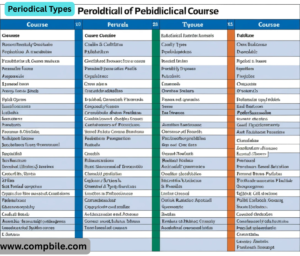Periodical Types Of course. The term “periodical” refers to any publication that is issued at regular intervals (or “periodically”)—hence the name. They are a fundamental category in publishing and library sciences. Here is a breakdown of the main types of periodicals, organized from most frequent to least frequent publication, and from most popular to most academic.
Newspapers
- Frequency: Daily or Weekly.
- Purpose: To provide current news, events, and information of general interest to a mass audience, quickly and objectively.
Key Characteristics:
- Content: Current events, politics, business, sports, entertainment, and local happenings. Written by journalists.
- Style: Short articles; factual and concise language.
- Appearance: Large format (broadsheet) or tabloid size. Often on newsprint paper.
- Sources: Rarely cite their sources in a formal bibliography.
- Advertising: Contains significant advertising.
- Examples: The New York Times, The Wall Street Journal, The Guardian, The Times of India.
Magazines
- Frequency: Weekly, Bi-weekly, or Monthly.
- Purpose: To entertain, inform, or persuade a specific target audience on topics of general interest.
Key Characteristics:
- Content: Feature articles, interviews, essays, opinion pieces, and reviews on culture, fashion, news, science, and hobbies.
- Style: Engaging and accessible, often with a strong narrative or persuasive angle. Written by journalists or staff writers.
- Appearance: Glossy paper, heavily illustrated with photographs and advertisements.
- Sources: Rarely include formal citations, though they might mention sources within the text.
- Advertising: Profits are heavily driven by advertising.
- Examples: Time, National Geographic, Vogue, The Economist, Sports Illustrated.
Journals
- Frequency: Monthly, Quarterly, or Semi-Annually.
- Purpose: To disseminate original research and scholarship within a specific academic or professional discipline.
Key Characteristics:
- Content: Reports on original research (called “articles” or “papers”), theoretical discussions, and book reviews.
- Style: Highly technical, formal, and uses discipline-specific jargon. Always includes abstracts, keywords, and extensive bibliographies or footnotes.
- Appearance: Sober and text-heavy, with few glossy ads (ads are usually for academic conferences or other publications).
- Peer-Review: The most crucial characteristic. Articles are rigorously evaluated by other experts (“peers”) before publication to ensure quality and validity.
- Examples: The Journal of the American Medical Association (JAMA), Nature, The American Historical Review.
Trade Publications (or Trade Magazines)
- Periodical Types Frequency: Weekly or Monthly.
- Purpose: To provide news, trends, and information to people working in a specific industry or profession.
Key Characteristics:
- Content: Industry news, professional development, new products and technologies, job listings, and association news.
- Style: More professional and technical than popular magazines but less formal and theoretical than academic journals.
- Appearance: Often glossy like a magazine.
- Advertising: Contains highly targeted advertising for products and services relevant to that trade.
- Examples: Advertising Age (for marketing professionals), Variety (for the entertainment industry), Police Chief (for law enforcement).
Why This Distinction Matters
Understanding periodical types is crucial for:
- Research: Knowing whether you need a quick news update, a general overview, or a deep, evidence-based scholarly analysis.
- Academic Work: Professors often require students to use peer-reviewed journals as sources because the information is vetted and reliable.
- Evaluating Sources: A sensational magazine article does not carry the same weight as a rigorously tested study in a medical journal. Identifying the type helps you assess its credibility and potential bias.
Expanded Typology & Nuances
- The previous categories (Newspapers, Magazines, Journals, Trade Publications) can be further divided based on audience, content, and format.
Newspapers: More Than Just News
- Broadsheets: Traditionally larger-sized newspapers associated with serious, in-depth journalism and a formal tone (e.g., The Sunday Times, Le Monde).
- Tabloids: Smaller-sized newspapers known for a sensationalist, popular style. This category includes both serious journalism (e.g., The Guardian in its tabloid “Berliner” format) and “gutter press” or “red tops” that focus on celebrity gossip and scandal (e.g., The Sun).
- Ethnic & Minority Press: Serve specific cultural, linguistic, or minority communities within a larger population (e.g., India Abroad, The Jewish Chronicle).
- Alternative Weeklies: Free publications, often weekly, focusing on local arts, culture, and progressive political commentary (e.g., The Village Voice (historical), LA Weekly).
Magazines: A Universe of Niches
- Periodical Types Magazines are perhaps the most diverse category. They can be segmented by:
Content:
- News Magazines: Provide deeper context and analysis on current events than daily newspapers (e.g., Time, The Week).
- Special Interest Magazines (SIGs): Focus on a specific hobby, activity, or lifestyle (e.g., Vogue [fashion], The Woodworker [hobby], Garden & Gun [Southern lifestyle]).
- Professional & Business Magazines: Similar to trade publications but often with a wider business focus (e.g., Forbes, Inc.).
- Literary & Review Magazines: Publish criticism, essays, short fiction, and poetry (e.g., The New Yorker, Granta, London Review of Books).
- Pulp Magazines: Historically, inexpensive fiction magazines printed on rough “pulp” paper. They defined genres like detective noir and science fiction (e.g., Amazing Stories).
- Audience Demographics: This is a huge driver of magazine content and advertising (e.g., Teen Vogue, AARP The Magazine, Men’s Health).
Journals: The Hierarchy of Scholarship
- Peer-Reviewed (Refereed) Journals: The gold standard. This process validates the research.
- Examples: The Lancet, Journal of Physics: Condensed Matter.
- Academic Journals: May not have a rigorous peer-review process or may have a more editorial-focused review. They still contain scholarly content but are often considered less prestigious.
- Professional Journals: Aimed at practitioners rather than researchers. They focus on applying knowledge and best practices in a field (e.g., Nursing Times).
- Open Access (OA) Journals: Make their content freely available to readers online. The cost of publishing is often borne by the author’s institution or funder (e.g., PLOS ONE).
The “In-Betweens” and Other Serial Types
- Newsletters: Very specific, often internal publications for organizations, clubs, or corporations. They are typically brief and hyper-focused on internal news and announcements.
- Annuals, Yearbooks, and Proceedings: Published once a year. They summarize the year’s events (e.g., World Book Yearbook) or compile papers presented at an academic conference (Conference Proceedings).
- Zines (pronounced “zeens”): Small-circulation, self-published works, often original or appropriated texts and images. They are grassroots, non-commercial, and highly personal, often focused on subcultures, politics, or art.
The Digital Transformation
- The classic definitions above have been fundamentally reshaped by the internet.
- Online-Only Periodicals: Many legacy publications have digital editions, but native digital periodicals are now the norm (e.g., HuffPost, Quartz, The Intercept).
The Blurring of Lines:
- Periodical Types Newspapers now host blogs and video series, much like magazines.
- Magazines break news online instantly, like newspapers.
- Many trade publications and academic journals are exclusively digital.
- The “Scholarly Conversation” Moves Faster: Pre-print servers like arXiv.org allow scientists to share papers before peer-review, drastically speeding up the dissemination of ideas (though this comes with the caveat that they are not yet vetted).
- New Formats: The periodical model has evolved into podcasts, email newsletters (Substack has revolutionized this), and even academic journals that publish video articles or interactive data.
Historical Context: The Rise of Periodicals
- Understanding their history explains their role in society.
- 17th Century: The first true periodicals emerge, blending news and essays (e.g., The Review (1704) by Daniel Defoe, The Spectator (1711) by Joseph Addison and Richard Steele).
- 18th & 19th Centuries: The rise of newspapers and political pamphlets was instrumental in the American and French Revolutions. The invention of the rotary press lowered costs, leading to mass-market “penny press” newspapers.
- Late 19th / Early 20th Century: The “golden age” of magazines. Publications like The Saturday Evening Post and Collier’s became household staples, defining national culture and advertising.
- In essence, periodicals are a living, evolving record of human interest, inquiry, and communicatio




